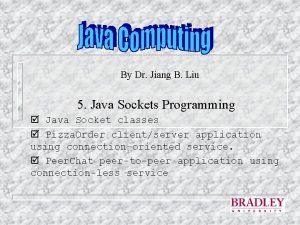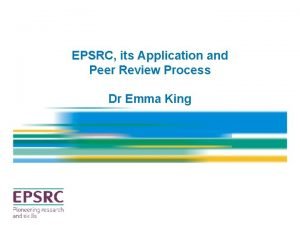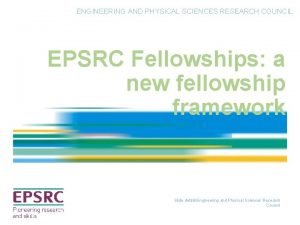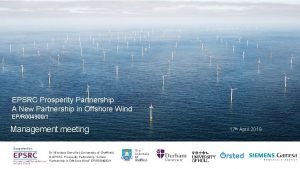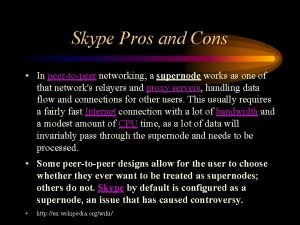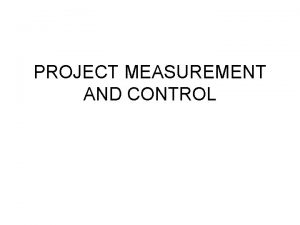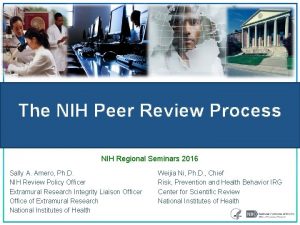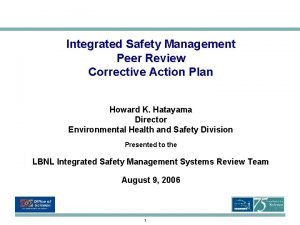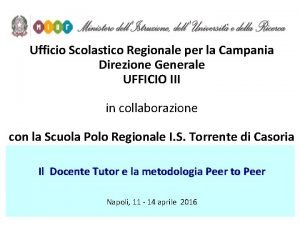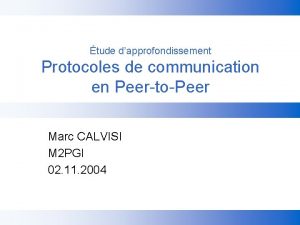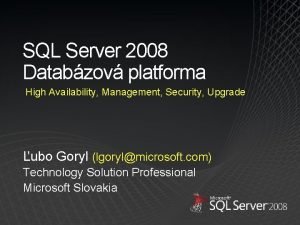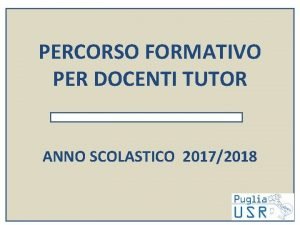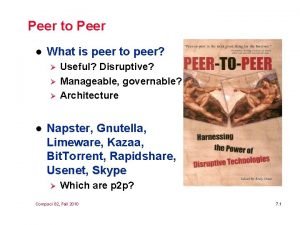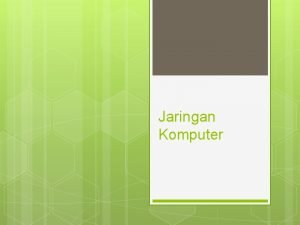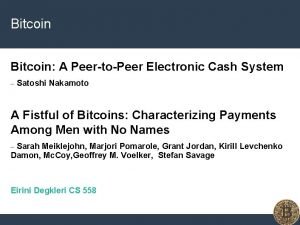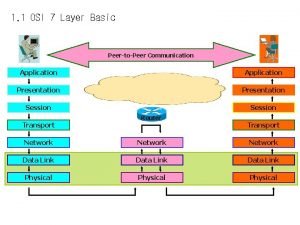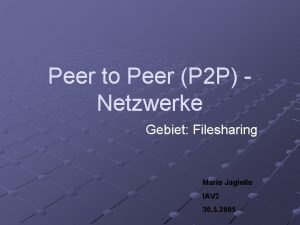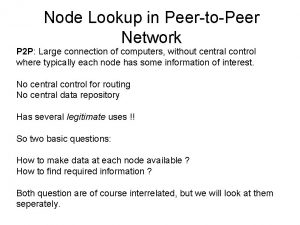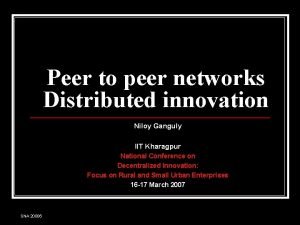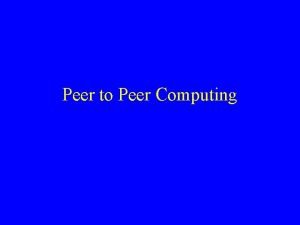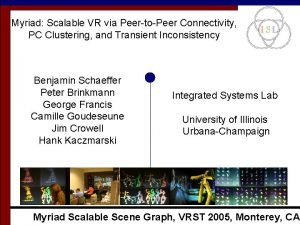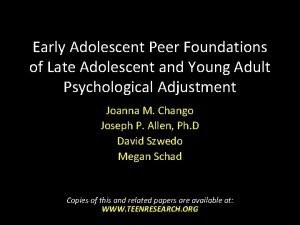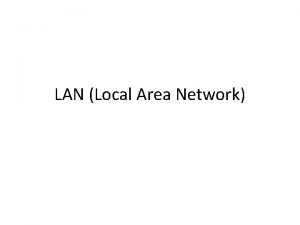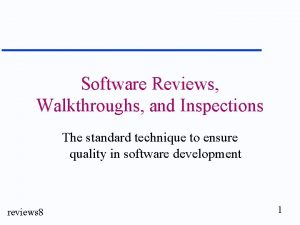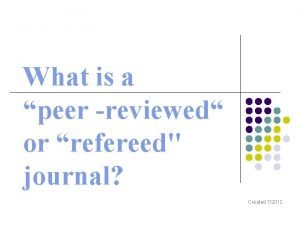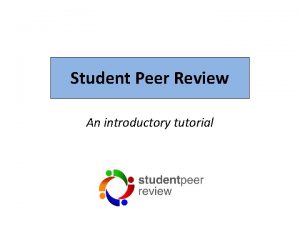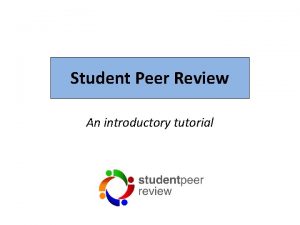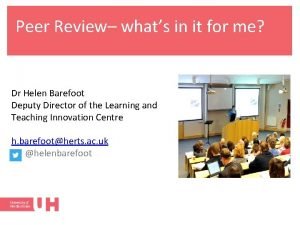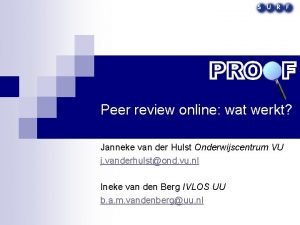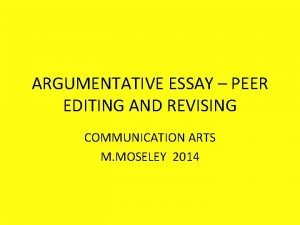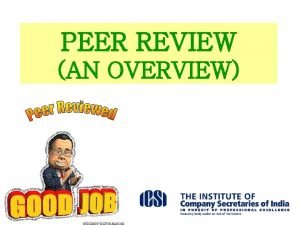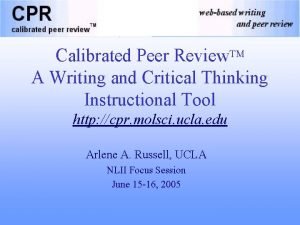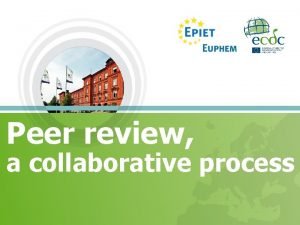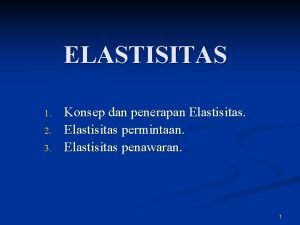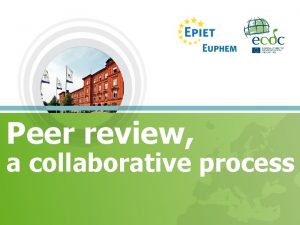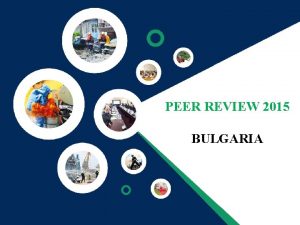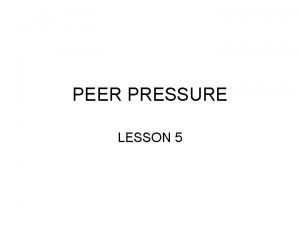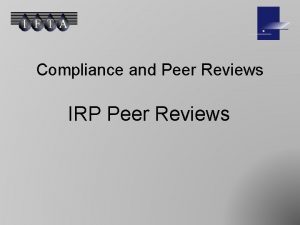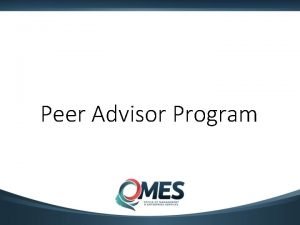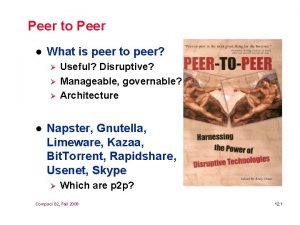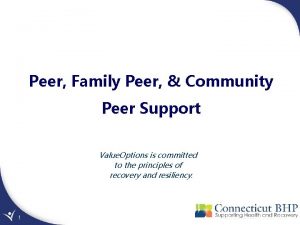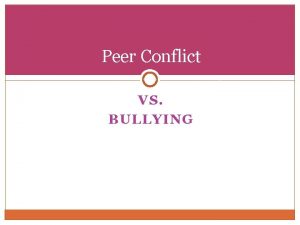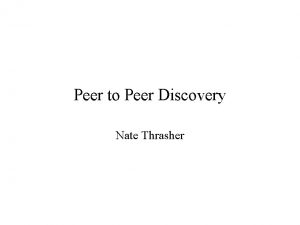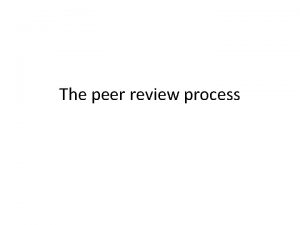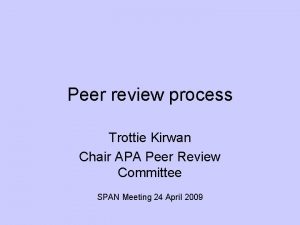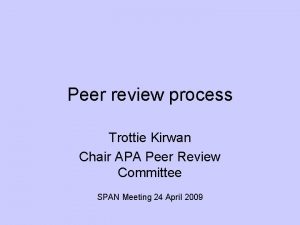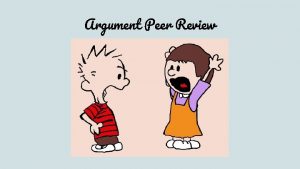EPSRC its Application and Peer Review Process Dr


















































- Slides: 50

EPSRC, its Application and Peer Review Process Dr Emma King

Myths, legends of EPSRC and its peer review system

If you make your proposal cheaper, the chances of being funded… a) Increase b) Remain the same c) Decrease

The maximum duration of a project is… a) 3 years b) 5 years c) There is no maximum

Project students… a) Have a maximum duration of 3 years b) Have a flexible duration c) Should be worked into the grave

Impact is… a) A needless burden that peer review doesn’t take any notice of b) The primary criterion for assessment c) Considered by reviewers in their assessment and as one of the secondary criteria at panel.

Of the nominated reviewers… a) At least one is asked to comment b) At least one is guaranteed to comment c) None will be asked

If a proposal receives a strongly negative reviewer comment the applicant should… a) Ignore it - the panel will make its own judgement b) Respond with a detailed rebuttal c) Give up as the proposal is doomed

Resources on funded grants are cut… a) When justified by peer review b) To meet the budget of each panel c) At the sole discretion of the panel

The criteria for the 12 month cooling-off period for unsuccessful applicants are… a) Three or more proposals ranked in the bottom half OR an overall personal success rate of less than 25% within a two year period. b) Three or more proposals ranked in the bottom half AND / OR an overall personal success rate of less than 25% within a two year period. c) Three or more proposals ranked in the bottom half AND an overall personal success rate of less than 25% within a two year period.

You can call or email us… a) By appointment b) At any time c) Via your head of department

Format of the session § Brief introduction to EPSRC, § EPSRC Application process, § Case for support and choosing nominated reviewers, § How to apply, § EPSRC peer review process, § Responding to reviewers, § Roles of panel members, EPSRC, § What happens next?

Brief Introduction to EPSRC

The Engineering and Physical Sciences Research Council § We are the main UK government agency for funding research and training in engineering and physical sciences. § We invest around £ 850 million a year so the UK will be prepared for the next generation of technological change. § One of seven Research Councils.

The whole EPSRC picture Values are commitment 2008 -11 Living with environmental change (£ 9 M) Global threats to security (£ 6 M) Ageing: life-long health and wellbeing (£ 11 M)

Essential Platform Programme Structure § Cross-Disciplinary Interface § Information & Communications Technology § Materials, Mechanical & Medical Engineering § Mathematical Sciences § Physical Sciences § Process, Environment & Sustainability § Public Engagement Commitment Budget 2008 -2011 £ 866 m (grants) £ 592 m (people) § Research Infrastructure & International

Mission and User-Led Programmes § Digital Economy § Energy Multidisciplinary Applications § Energy Research Capability § Nanoscience through Engineering to Application § Towards Next Generation Healthcare Commitment budget 2008/11 £ 398 § Knowledge Transfer § User-Led Knowledge & Skills § User-Led Research Commitment budget 2008/11 £ 482

Research Grants: Research Base § No closing dates, § Any topic in EPSRC’s remit, § Research direction decided by applicant, § Primary assessment criterion is quality, § Highly flexible – support from £ 1 k £ 5 m, can include; § Travel grant; § Visiting fellow; § Project students; § Proof of concept; § Equipment.

Research Grants: Targeted Calls For research in a particular subject area: § Proposal must meet certain criteria to be considered against the call, § Assessment criteria will be given, § Fixed closing date, often an outline stage, § Latest calls for proposals at www. epsrc. ac. uk, § Sign up for an automatic e-mail alert.

Application process – what to include

A standard proposal has: § Application form (Je. S form). § Case for support to include: § § Track record of applicants (max 2 sides of A 4), § Description of proposed research (max 6 slides of A 4), § Diagrammatic work-plan (1 side of A 4), § Justification of Resources (up to 2 sides of A 4), § Pathways to impact (up to 2 sides of A 4), Annexes – only allowed: § Letters of support, § Equipment quotes, § CV for visiting Researchers and RAs (max 2 pages each of A 4).

Good Work Plans § Are clear and easy to read. § Describe the work that is proposed, so: § Match the work packages in the case for support, § Show the work packages are linked. § Explain the different roles in the proposal.

Justification of Resources (Jo. R) A separate document to the case for support. § Should clearly describe what is being asked for, how much and why you need it, § Should justify every item you request in your Je. S form, apart from the estates and indirect costs, § PI and Co. I time should be justified rather than the cost.

Poor Jo. Rs: § Lists without including a justification of why it is needed. § Hard to read, layout doesn’t follow the costings on the Je. S form. § Misses out justifications for costings in the Je. S form. § Costs/items in the Je. S form don’t match the ones in the Jo. R. § Doesn’t to justify the PI and Co. I time in the grant. § Doesn’t justify or explain the travel and subsistence section. § Mix up pooled technicians with infrastructure technicians. § Ask for money to supervise Ph. D students – not allowed.

Pathways to Impact Research Council description: ‘The demonstrable contribution that excellent research makes to society and the economy. ’ Aims: § NOT to change the type of research, § To encourage applicants to think about the potential impact of their research at the time of planning it, § ‘Impact’ does not equal ‘applied’ or ‘industry’.

Pathways to Impact Implication for applicants: § Two new sections on Jes form: § Impact summary, § Academic beneficiaries. § Case for support attachment: § Pathways to impact – separate document expanding information in summary. § Resources: § Ask for and justify what you need, § Consider timescales of a project.

Letters of Support Only include if they add to the proposal. § For example, letters that say “I support this proposal and look forward to the results” are not strengthening the case for the proposal. § Good letters of support are those that contribute to the proposal (in cash or in kind). § Note that letters of support can not be added to the proposal after it has been submitted through Je. S.

Writing the Case for support

Considerations before applying: § Idea should be: cutting edge science; creative; value for money; adventurous; have significant impact (on whom)? § Is this appropriate for collaboration? § Is this suitable for a multi-project application? § Is this multi-disciplinary? § Suitable for long-term (more than 36 months)? § Should/could this be a feasibility study?

Consider the audience you are writing to: § Look at the reviewer forms, (on website at: http: //www. epsrc. ac. uk/Forms/Reviewers/default. htm). Emphasise – these are the people to convince; they are the experts in the research field. § Be clear about the ideas and management issues. § Provide a good, clear and concise work-plan. § Panel Assessment Criteria. § For targeted calls – objective of the call and criteria.

Advice on choosing nominated reviewers Choose: § People who are experts in the research field and/or able to judge the value of the research to people who might use its results. Don’t choose: § Someone who has a close working relationship in the past e. g. Ph. D supervisor. § Or now e. g. project partner, someone from the same organisation as the PI or Co. Is. § More than one reviewer from the same organisation.

How to apply

§ EPSRC Staff can NOT access Je. S. § Proposals can NOT be submitted after a call closing date / time. § Once a proposal is submitted, it can NOT be changed.

To note: § Checks on costings, documentation are performed at the registration stage. Once registered, any amendments needed, proposal will have to be rejected. § Jo. Rs are checked just before the reviewers are added. If incorrect, it will be returned to the PI to amend. Have one chance to amend, if still not right will be rejected.

Top tips § Speak to your Research Office for costings and how to use Je. S, § Get someone who is successful at getting funding from EPSRC to read through your proposal, § Ask to see successful grant applications and unsuccessful, § Get someone who is on EPSRC peer review college to read your grant and to assess it as a reviewer would.

Peer Review Process

The Peer Review Process § Standard – reviewers then panel. § Targeted – vary according to the scheme/call, this could be: § Panel only, § Reviewers then interviews etc.

The Peer Review Process Proposal Portfolio Manager PI Response Rank Order Reviewers: Unsupportive One from Proposer Two from College Supportive Budget Rejection EPSRC College Peer Review Panel from Council Not Fund Head of Programme Fund

Who are the reviewers? Approach at least: § One of three reviewers nominated by applicant – (think carefully who you nominate), § Two members of the EPSRC College of experts. May also approach: § Other independent reviewers, § Previous reviewers for continuity for invited resubmissions.

Research Base Panel Reviewer Criteria Assess against: Assess whole proposal as: § Excellence, Novelty, timeliness, context, ambition, adventure, methodology. § Impact, Beneficiaries, collaborators, dissemination, knowledge exchange. § Applicant, Skills, track record, research partners, ability to deliver. § Resources & Management. § Overall assessment. § Very strong – fully meets criteria. § Strong – broadly meets criteria. § Good – meets criteria with minor weaknesses. § Meets criteria but with clear weaknesses. § Does not meet one or more criterion. § Flawed.

Applicant Response to Reviewers § Panels place great emphasis on the usefulness and quality of the response. § Lack of suitable response to key issues may lead to a lower ranking of a really good proposal. § Read reviewer comments carefully and provide a balanced response. § Respond to ALL reviewer comments (five working days to respond).

Role of the Panel Their primary role is: § To generate a rank ordered list of research proposals in priority order for funding. Based on: § The assessment of the reviewers. § The proposer’s response to reviewers. § Technical assessments from facilities (if relevant).

Role of the EPSRC at the Panel The role of EPSRC Officials is to: § Facilitate the meeting, § Offer guidance on EPSRC rules and procedures, § Record decisions and comments, § Feedback any advice from the Panel to applicant. Outside the meeting: § To determine the funding cut-off and allocation of resources to the competing proposals.

The Panel Process § Two speakers per proposal – one expert, one generalist. § Speakers score each section of the reviewer form (quality, impact, applicant(s) ability, resources and management) based on the reviewer comments and PI response to these. § Overall score - based on the individual criterion scores. § Speakers and panel agree overall score and rank position based on the speaker pre-scores and discussions. § Note: scores are only a tool used at panel to generate the rank ordered list. Rank position is important not the score.

What happens next? § Funding meeting with Ho. P and convenor – funding decisions made. § Confirmation letter within two weeks after the panel. § Feedback – only if panel direct.

What happens if the proposal is not funded? Resubmissions: § No longer accept uninvited resubmissions. § Definition: any proposal submitted to EPSRC through any funding scheme, Or any proposal considered by another funding scheme. § If a proposal is submitted and it’s a resubmission, then it will be rejected. Count as unsuccessful application.

12 month cooling-off period for unsuccessful applicants Why are we doing this? § To help alleviate pressure on all involved in peer review. What is the criteria for selection? § PIs who have three or more proposals within a two year period ranked in the bottom half of the prioritisation list or rejected before panel, AND an overall personal success rate of less than 25% over the same two years. When does the policy come into place? § April 2010. § Monthly email to affected applicants, copied to RO.

Applicants meeting the criteria: allowed to submit one application during the next 12 months and asked to review their resubmission behaviour. What is the purpose of the cooling-off period? § For applicants to assess submission behaviour and, if appropriate, seek advice from colleagues about the application process or submission strategy. How will a cooling-off period end? § Automatically ends 12 months after the start date. We will expect to receive details about what steps have been taken to address issues with submission behaviour.

What happens if the proposal is funded? § Offer letter pack is sent. § Pack includes starting certificate. § Once the PI starts the project, your finance office submits the starting certificate.

Do you want to find out more information? See www. epsrc. ac. uk: http: //www. epsrc. ac. uk/funding/Pages/default. aspx http: //www. epsrc. ac. uk/funding/apprev/Pages/default. aspx http: //www. epsrc. ac. uk/funding/forms/Pages/default. aspx Come to a EPSRC Study Day: http: //www. epsrc. ac. uk/about/partner/universities/Pages/studydays. aspx Contact: emma. king@epsrc. ac. uk 01793 44 4419.
 Peer to peer chat application in java
Peer to peer chat application in java Epsrc response to reviewers
Epsrc response to reviewers Epsrc postdoctoral fellowship
Epsrc postdoctoral fellowship Epsrc prosperity partnerships
Epsrc prosperity partnerships Features of peer to peer network and client server network
Features of peer to peer network and client server network Pros and cons of using skype
Pros and cons of using skype Direct and indirect measurement
Direct and indirect measurement Nih peer review process
Nih peer review process Peer review corrective process
Peer review corrective process Annotazioni sulla verifica effettuata peer to peer
Annotazioni sulla verifica effettuata peer to peer Peer-to-peer
Peer-to-peer Tim beamer
Tim beamer Peer to peer transactional replication
Peer to peer transactional replication Gambar topologi peer to peer
Gambar topologi peer to peer Registro peer to peer compilato
Registro peer to peer compilato Scheda osservazione tutor compilata
Scheda osservazione tutor compilata Relazione finale tutor tirocinio esempio
Relazione finale tutor tirocinio esempio Peer to peer l
Peer to peer l Peer to peer merupakan jenis jaringan… *
Peer to peer merupakan jenis jaringan… * Bitcoin: a peer-to-peer electronic cash system
Bitcoin: a peer-to-peer electronic cash system Ambiti operativi da supportare
Ambiti operativi da supportare Peer-to-peer communication in osi model
Peer-to-peer communication in osi model Peer p
Peer p Addresss look up
Addresss look up Peer-to-peer o que é
Peer-to-peer o que é Peer to peer computing environment
Peer to peer computing environment Peer intervention program
Peer intervention program Peer-to-peer o que é
Peer-to-peer o que é Peer-to-peer o que é
Peer-to-peer o que é Peer to peer network hardware
Peer to peer network hardware Jaringan peer to peer diistilahkan dengan
Jaringan peer to peer diistilahkan dengan Peer review walkthrough and inspection in software testing
Peer review walkthrough and inspection in software testing Introduction to pr
Introduction to pr Refereed journal definition
Refereed journal definition Peer review examples for students
Peer review examples for students Best introduction lines for students
Best introduction lines for students Purpose of peer review
Purpose of peer review Sham peer review how to stop
Sham peer review how to stop Janneke luiken
Janneke luiken Icsi peer review
Icsi peer review Editing argumentative essay
Editing argumentative essay Qualtrics 360 degree feedback
Qualtrics 360 degree feedback Peer review certificate meaning
Peer review certificate meaning Calibrated peer review
Calibrated peer review Calibrated peer review
Calibrated peer review Peer review wiki
Peer review wiki Um peer review
Um peer review Beto peer review
Beto peer review Elastisitas harga
Elastisitas harga Static equilibrum
Static equilibrum Elasticity and its application in economics
Elasticity and its application in economics
